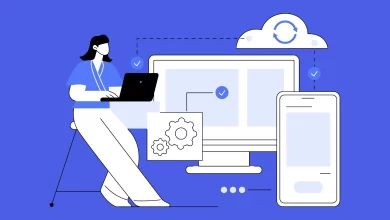7 Reasons Why Web Development Is Important for All Types of Businesses

The advent of digital technology has changed the way companies operate, especially how they connect with customers.
Web development is central to this digital revolution. It is a bridge between businesses and their customers, enabling interaction, accessibility, and commerce on a scale that was previously unimaginable.
Understanding the importance of web development is a must for businesses of all sizes and sectors. And it’s not just about having an online presence, it’s also about having a platform that resonates with customers, drives engagement, and fuels growth.
In this article, we’re delving into seven key reasons why web development is important for all types of businesses.
1. Accessibility Around the Clock
A website is the embodiment of a business that never sleeps. Its 24/7 availability isn’t just a feature. It’s a fundamental change in how businesses are accessible to their customers.
Unlike physical stores constrained by location and operating hours, websites provide customers with a persistent, always-open gateway, irrespective of time zones or geographical barriers.
This round-the-clock accessibility translates into uninterrupted opportunities for browsing, inquiries, and purchases.
Consumers can interact with businesses on their own schedule, be it late-night shopping, early morning service inquiries, or anytime in between. Moreover, it extends a business’s reach far beyond local markets, opening doors to global audiences.
2. Improved Customer Engagement
A key function of a well-designed website is its powerful capacity to engage customers effectively.
Engagement is about creating a connection with the visitor, compelling them to explore more, and ultimately, driving them to take action, whether it’s making a purchase, signing up for a newsletter, or reaching out for more information.
This engagement depends on the user experience (UX) and user interface (UI) design of the website.
UX design focuses on the overall feel of the experience, ensuring that the website is easy and satisfying to navigate. On the other hand, UI design is about the specific elements users interact with on the website – the layout, the buttons, the graphics, and other visual elements.
3. Establishing Brand Identity and Credibility
A website often forms a customer’s first impression of a business. It is like a digital storefront that reflects the business’s values, ethos, and professionalism. This is why it should communicate a strong brand message and identity.
The aesthetics of a website – its color scheme, typography, imagery, and overall design – play a big role in how a brand is perceived. A well-designed website conveys professionalism and attention to detail, instilling confidence and trust in potential customers. This trust is key to building long-term customer relationships and fostering loyalty.
On the contrary, a poorly designed or outdated website can raise doubts about a business’s legitimacy and quality, which can drive potential customers away.
Additionally, consistency in web design across all pages contributes to strong brand recognition. When customers encounter a consistent visual and thematic experience, it reinforces brand memory.
To ensure a cohesive brand experience, brands should extend this consistency beyond the website to all digital presences, such as social media platforms.
4. Central Hub for Marketing and Promotion
A business’s website is like a central hub around which all other online promotional activities revolve. In the digital marketing ecosystem, the website is where strategies converge and where potential customers are directed to learn, interact, and make decisions.
One primary way to leverage a website for marketing is through Search Engine Optimization (SEO). Businesses can enhance their online visibility by optimizing the site with relevant keywords, quality content, and a mobile-friendly design.
The result? A wider audience brought organic traffic to the site, and all this with minimal advertising expenditure.
Content marketing is another strategic element that relies heavily on a strong web presence. Regularly updated blogs, articles, case studies, and videos keep the site dynamic and encourage repeat visits while also providing material that can be shared across social media platforms.
5. Competitive Edge in the Market
A sophisticated, user-friendly, and content-rich website sets a business apart from competitors who may not have invested as heavily in their online presence. This advantage manifests in several key areas.
Firstly, an advanced website typically offers a superior user experience. Features like fast load times, mobile responsiveness, and easy navigation attract visitors and retain them, reducing bounce rates and increasing the likelihood of conversions.
Additionally, a well-optimized website is more visible on search engines. Businesses with SEO-optimized websites are more likely to appear on the first page of search results. And this matters because most users rarely look beyond the first page of search results.
In contrast, businesses with outdated or poorly functioning websites suffer. These websites often struggle with low visibility, poor user engagement, and diminished credibility. They miss out on the vast potential of online traffic and fail to capitalize on digital marketing strategies.
6. Non-Stop Marketing and Promotion
Unlike traditional marketing channels, which are often time-bound or require continuous investment, a website is a one-time investment that keeps on giving.
It provides a platform for continuous exposure and endless marketing opportunities, accessible to customers anytime and anywhere.
The 24/7 nature of a website means that it works tirelessly, showcasing products, services, and content even when the physical business operations are closed. It ensures that the business is always open to engaging with customers, answering their queries through automated services like chatbots, and facilitating transactions.
Moreover, the website is a repository for a wide range of marketing content — from blogs and videos to infographics and e-books. This content can be strategically used for inbound marketing, attracting customers through value-driven material that educates, entertains, and informs.
7. Data-Driven Insights and Strategy
A website is also a rich data source about customer behaviors, preferences, and interactions. Using this data allows businesses to make informed decisions and strategize with precision.
Web analytics tools can track various metrics such as page views, bounce rates, user engagement, and conversion rates. This information provides insights into what attracts visitors, what holds their interest, and what prompts them to take action.
Businesses can then use these insights to refine their website design, content, and functionality.
Furthermore, analyzing user data helps in understanding customer preferences and buying patterns. Then, it’s easy to identify popular products or services, peak usage times, and demographic details of their audience.
Data-driven decision-making extends beyond the website. Insights gleaned from web analytics can influence broader business strategies, including market expansion, customer service improvements, and operational changes.
For example, if data shows that a significant portion of website traffic comes from mobile devices, a business might prioritize mobile optimization and app development.
Conclusion
From providing round-the-clock accessibility to leveraging non-stop marketing and offering data-driven insights, a well-developed website is a powerful asset for any business looking to succeed.
Each of the points discussed underscores how integral web development is to standing out, enhancing customer engagement, and driving business growth.
However, if you want to work with professionals, it’s best to consult a reputable web development agency in your city. These experts will help you take the first step towards digital transformation and long-term success.



